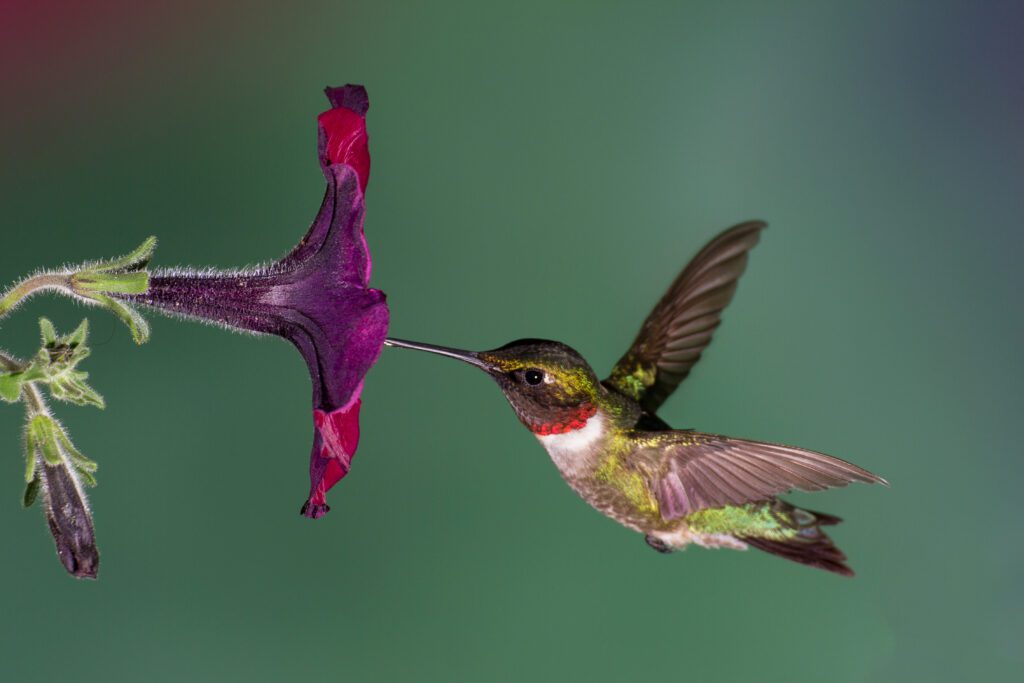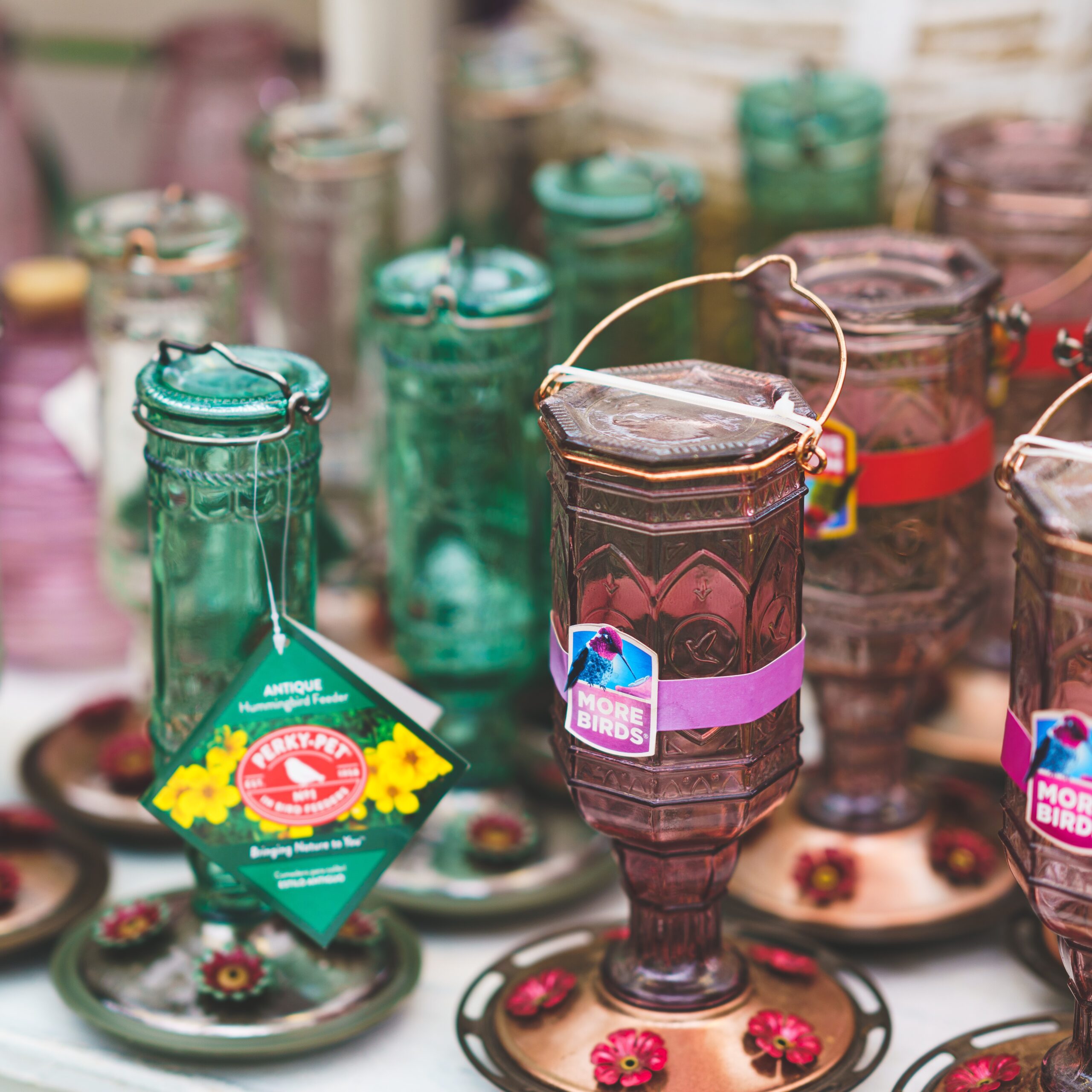April 14, 2025
When to Put Out Hummingbird Feeders in New England
Welcoming Hummingbirds Back: What to Know About Spring Migration
Each spring, ruby-throated hummingbirds return to New England after a long migration. These tiny birds fly thousands of miles from Central America and the southern U.S. back to our gardens—and your backyard can be part of their journey.
Setting out feeders and planting pollinator-friendly flowers isn’t just helpful—it can actually encourage hummingbirds to return again and again. Here’s how (and when) to make your garden a hummingbird haven this season.

A ruby-throated hummingbird flying into a petunia flower.
Why You Should Put Out Hummingbird Feeders Early
Getting your hummingbird feeders up before the first sightings in your area is more important than you might think. When a hummingbird stops at your feeder during spring migration, two things happen:
-
It remembers your garden as a stop, and may return in the fall on its way south.
-
It may stay in your area rather than continuing to search for food—especially if your feeder is one of the first it finds.
This is why early placement (early April in New England) is key. Even if you don’t spot a hummingbird right away, you’re helping travelers find the energy they need to finish their journey—and giving them a reason to return.
When Do Hummingbirds Arrive in Massachusetts and the Northeast?
In most parts of Massachusetts and surrounding states, ruby-throated hummingbirds return between late April and mid-May, but they may begin arriving as early as the first or second week of April.
By putting feeders out no later than early-mid April, you’re ready for early migrants and won’t miss your chance to attract the season’s first visitors.
Why Do Hummingbirds Migrate?
Hummingbirds migrate in response to seasonal changes in food availability. As flowers and insects disappear in the fall, these birds head south to warmer regions rich in nectar and protein sources.
Come spring, they make the trip north again—sometimes flying up to 500 miles nonstop across the Gulf of Mexico. It’s an exhausting journey that depends on finding reliable food sources along the way.
How to Support Hummingbirds in Spring
As these energetic birds pass through, they need plenty of fuel to keep going. Here are some ways you can make your yard a hummingbird haven:
-
Put Your Feeders Out in April and Offer High-Quality Nectar
Even if you don’t see hummingbirds right away, they’re on the move. Having a feeder ready helps you catch early arrivals and turn your yard into a seasonal stop they remember.
Hummingbirds rely on nectar as a primary energy source. You can provide them with an easy-to-make nectar solution by mixing four parts water to one part white granulated sugar. Avoid using red dye, honey, or artificial sweeteners, as they can be harmful to birds. If you prefer a convenient option, our garden center carries high-quality hummingbird nectar that’s specially formulated for their health and hydration.
-
Keep Feeders Clean and Fresh
Dirty feeders can grow mold and bacteria, which can harm hummingbirds. Clean your feeders every few days—more frequently in hot weather—with warm water and a mild vinegar solution. Be sure to rinse thoroughly before refilling.
-
Plant a Pollinator-Friendly Garden
Hummingbirds are naturally drawn to nectar-rich flowers. Adding native plants like bee balm, salvia, cardinal flower, and trumpet vine can provide them with an additional food source while enhancing your garden’s beauty. Our garden center offers a variety of hummingbird-friendly plants to help you create the perfect habitat. You can also check out this plant list that will let you know exactly which plants we consider hummingbird caviar.
-
Provide Shelter and Perches
After a long journey, hummingbirds appreciate places to rest. Small trees, shrubs, and even strategically placed feeders near branches can give them a spot to perch between feedings.
-
Leave Your Feeders Up a Bit Longer
Some people worry that keeping feeders out too late in the season will prevent hummingbirds from migrating, but this isn’t true. Migration is triggered by daylight changes, not food availability. Keeping feeders out into early fall can help late migrants or young birds that need extra energy for their journey.

Hummingbird feeders at Mahoney’s Garden Center in Winchester, MA.
How Do I know if Hummingbirds are here?
Watch for these signs of hummingbird activity:
-
Quick flashes of iridescent green or red
-
Hovering and darting flight patterns
-
Buzzing wing sounds near feeders and flowers
Males usually arrive first to claim territory, followed by females a few weeks later.
Migration timing varies by region. In New England, hummingbirds typically arrive in mid to late April and leave by mid-September. To track their migration in real time, check out the interactive map below. You can add your own sightings to the map as well as download the app for your phone here!
Get Ready for Hummingbird Season!
Whether you’re preparing for spring arrivals or giving late-season travelers a boost, our garden center has everything you need to attract and support hummingbirds. Stop by any of our 7 locations to explore our selection of feeders, nectar, and pollinator-friendly plants—your backyard visitors will thank you!
By creating a welcoming environment, you can enjoy the magic of hummingbirds all season long while playing a vital role in their incredible migration journey.
